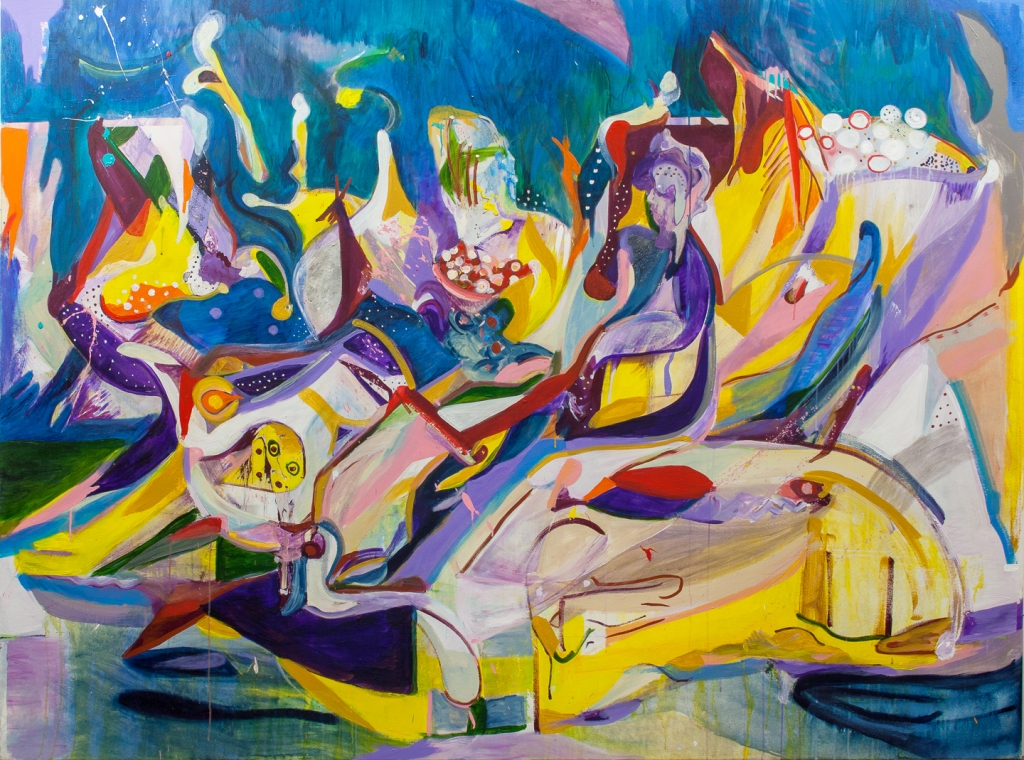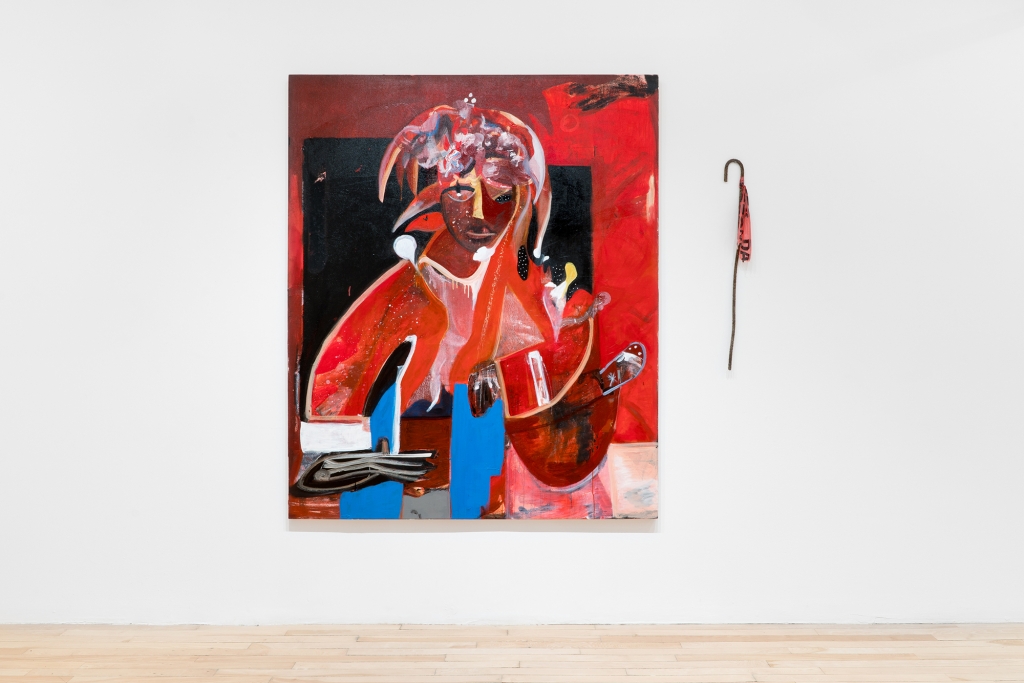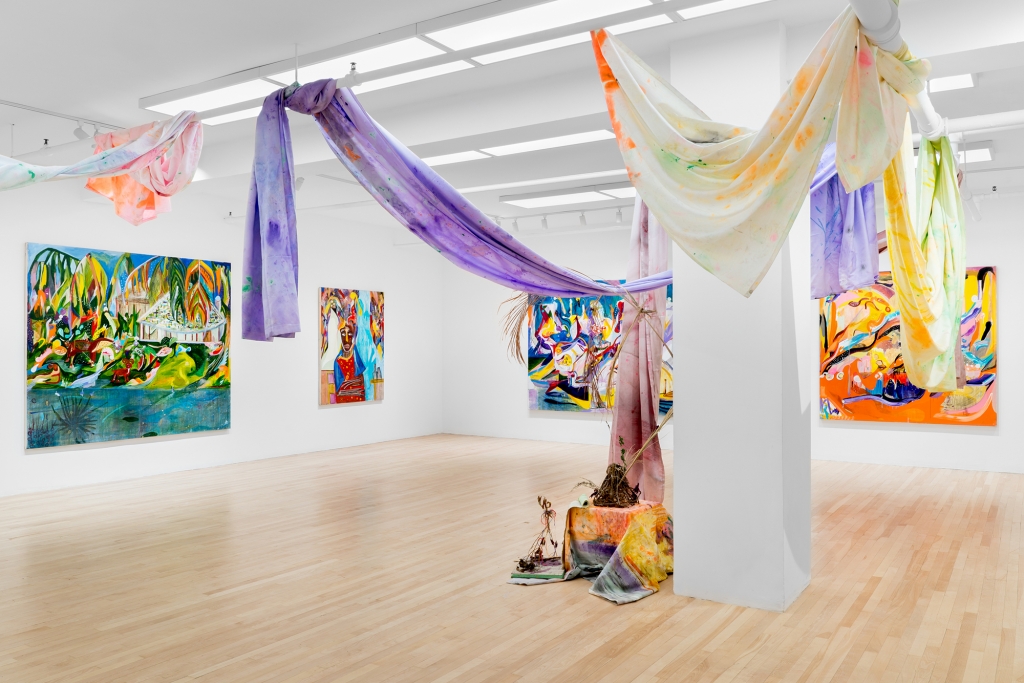November 9 – December 21
Espas Sakre was Desvarieux’s first solo exhibition at Galerie Hugues Charbonneau where he is newly represented. The show was part of the Pictura triennial of Montreal painting. Here he pays homage to his many influences and shares what he has learned about painting since he began making art in 2013. The works here show a rapid progression and integration of many aesthetic interests including Modern Art, Abstract Expressionism, and Haitian art, exploring a full spectrum of figuration and abstraction in mostly large acrylic paintings. Desvarieux is an omnivorous painter, synthesizing fragments of Basquiat, de Kooning, Picasso, Hilma af Klimt, Peter Doig, and others, but rather than becoming derivative, he has been expanding his personal range. These works are idealistic, energetic, and holy. They depict a paradisiacal vision of the Haiti of the artist’s hopes and dreams. Many of the interpretations that follow are extracted from an interview I did with the artist in the gallery in December 2023.

installation view
What is immediately apparent is Desvarieux’s sense of colour and form, his painterly virtuosity, his sophisticated sense of rhythm, his references, and his very apparent love of creating. In many ways, he is a painter’s painter. Going deeper however, there are cultural mythologies being shared, spirits being invoked, and new ways of existing being called forth. Desvarieux said “Haiti is Vodou”, and that Vodou is in the gastronomy of Haiti, the land, the language, and much of the music. I was told that all of the elements and all of nature are understood to be loa, spirits or deities. This animism gives practitioners of Vodou—of which there are still many in Haiti—a great reverence for the land and for the spirits they work with and for. Desvarieux learned about Vodou, his culture, his upbringing, and his ancestry through researching what was available to non-initiates and applying what he found to his painting.
Desvarieux was born in Port-au-Prince and has been living in Montreal for many years. He comes from a political Haitian family who were art collectors, so he grew up surrounded by paintings and the works of many celebrated Haitian artists. Desvarieux came to Montreal to complete his education and discovered his true path was in making art. He is the co-founder of Montreal art collective Atelier Good People, and besides being a painter and community leader he is also a photographer. I first saw his work in person in a group show at Galerie Hugues Charbonneau, Imaginaires souverains, in 2022, and then again in a duo show in 2023 called Le langage secret de l’univers at Maison de la Culture Claude-Léveillée, Montréal. Desvarieux has also shown recently at Sargent’s Daughters in Los Angeles and at the Musée des Beaux-Arts Montreal. His painting has been rapidly progressing in very interesting ways, and with this solo show, it is clear that his work has gained enough strength to show that he is a formidable painter.
Those who are familiar with the history of Haitian art might recognize in his influences most notably Andre Pierre and Hector Hyppolite, Vodou priests who painted scenes of Vodou who painted the loa often. The landscapes of Haiti with heavy tropical foliage, bustling with energy and life, and scenes of Vodou religious rites and loa are evoked in Desvarieux’s works such as Ogou Fè and Legba Mèt Lakou as they are in the work of Pierre. They are intrinsically Haitian with their reverence for the land, the loa, and the ideals they convey.

Legba Mèt Lakou
Desvarieux’s art practice is deeply spiritual and pulls strongly on his experience of being raised surrounded by Vodou. His process is ritualistic, intuitive, and reverent. Loa Legba greeted us at the beginning of the exhibition—you had to pass by him to go further—he stood at the crossroads between the outside world and the sacred space created for us. Legba Mèt Lakou shows Papa Legba of the crossroads, a trickster God who Desvarieux has painted many times. In Vodou you cannot do magic without Papa Legba. He is a deity of the arts, loa of writers, painters, and he dwells in the in-between spaces where invisible becomes visible. This is also the domain of art. Here Papa Legba, wearing a suit of red and black, sits casually in nature and it seems as if dusk is coming on and some stars are visible. He is surrounded by the lush tropical flora of Haiti by the edge of the land and water. Legba seems as if he was waiting for you, but he is in no sort of hurry. His eyes meet yours, his large hands dangle at rest, he seems to accept you, as if he may let you pass. Those familiar with the history of art will see in this painting touches of Cubism, of Basquiat, of de Kooning. Painters will admire the complex but harmonious layering in this large canvas.

Marasa
The next paintings are a diptych, two panels placed close beside each other, titled Marasa, they seem to reference the moon and the sun, respectively. The left panel has a grey disk rising over tropical waters with heavy plants surrounding the view, it is done mostly in cool purples and greens, a self-contained lunar scene. On the right panel, we find warm tones, solar tendrils, an expansive energy above a simple horizon line, a land in summer bleached by the hot sun, or a giant orange lily blooming in the equatorial heat. In Tantra, the left is feminine and lunar, while the right is masculine and solar. In many traditions the left hand path is considered dark, and the right is associated with light. These two panels call to mind Yin and Yang, divine feminine and divine masculine, and the harmony of opposites. Desvarieux told me that to create this diptych, he had a process that is rooted in the meaning of the painting itself. He gessoed two canvases, stuck them together, and once they began to dry, he ripped them apart, and with a resoundingly loud crack, one became two. I enjoyed hearing how his process was ritualistic, as if the painting itself is initiating some magical process which echoes the creative energies of the universe. In Vodou, Marasa are the sacred twins, road openers, the guardians of the threshold who it is necessary to invoke after Legba before proceeding with the ritual. Esoterically the first emanation of life is where one becomes two, and Desvarieux said that he wanted to make a gesture which represents that divide, likening it to splitting the atom. In the mythology of Plato’s Symposium, humans were created with four arms, four legs, two sets of sexual organs, and a single head with two faces. These early human beings were thought to be powerful, whole, and physically perfect. The Gods felt threatened by these strange creatures and Zeus divided them, splitting the unit into two, leaving the pair forever fated to seek union with their other half, thus creating some of the modern lore of soulmates which persists to this day.
Hanging throughout the gallery were hand-dyed fabrics in purples, yellows, greens, and pinks which were sometimes one whole colour, sometimes fading from one to another, and splotched throughout. The colours and patterns mimicked the dance of vibrations in the canvases below. They both accentuated and sheltered the works, and created a sacred space within the sacred space for the small natural altar at the centre of the gallery. It was a humble ephemeral altar which paid tribute to the two lands on which Desvarieux has lived, palm for Haiti and sweetgrass for Canada. The effect of the hangings made the exhibition feel a little bit like it was on a stage. He said that Haitian Vodou is theatrical, it is both serious and joyous with a lot of ornaments, smells, food, and music. Coloured fabrics are also used in Vodou rituals to signify different loa.

ephemeral altar, closeup view
Lakou lanmou I is a pastoral which pays tribute to indigenous, green, and sustainable architecture. We see a dirt or mud house with leaves for roof amid a colourful and lush paradise at the edge of the sea. There is a horned mythological creature on the coast and the water before it feels deep, luminous, and alive. This Arcadia which shows a sacred space existing in harmony with nature. Lakou in Haitian Creole means a courtyard, a natural setting in a communal dwelling place, while lanmou means love. It is a representation of an idyllic pastoral setting, a realm that seems peaceful, lush, and safe. You can see the influence of Peter Doig in this work, particularly in the water and the palm trees. Doig is also an artist with deep connections to both the Caribbean and Canada, and his big survey exhibition at the Montreal Museum of Fine Arts in 2014 would have been not long after Desvarieux started painting.

Lakou lanmou I and Autoportrait dans la zone des ombres colorées
Desvarieux spoke of what is happening in Haiti right now, of the fact that Catholic and Protestant missions are still very active there in trying to stamp out Vodou. Temples have been destroyed and forests cut without respect for the land. The missions have been taking advantage of natural disasters such as the earthquake of 2010 to entrench their influence. They built schools and thus seem philanthropic but families are split apart and children are taught that their culture is evil, according to Desvarieux, the children do not even learn their own history. The shame that happened in the residential schools in Canada is happening in Haiti today. Haiti does not need help from the Church to civilize the people, without outside interference and exploitation, Haiti could thrive.
Autoportrait dans la zone des ombres colorées is a bit more personal as it depicts Desvarieux in his studio, seeming to wear as a headdress the dyed curtains that could also be seen hanging in the gallery. He said that his eye was caught by a shadow cast by a candle. He looks pensive but comfortable, and his crossed arms, just simplified white sticks, invoke Basquiat. His eyes, here painted blue, regard what seems to be a cascading waterfall. The assemblage of abstracted patterns, colours, and the turquoise water-like forms are full of movement and life, as if they could be the tumult of thoughts and feelings that move despite the stillness of the body. The self-depiction seems almost royal, the fabrics and patterns African and resplendent, but this auto-portrait is also humble and discrete. The idea of coloured shadows is familiar to artists, even in a seemingly black shadow there are subtle reflections and nuances of colour. There is an idea in Vodou philosophy that the religion contains all duality, good and evil, it accepts the polarities of life as part of the grand scheme of existence. It stands in contrast to Christianity, where evil is seen as the realm of Satan. Vodou is judged by many in the West to be an uncivilized religion based in devil worship, animal sacrifice, and curses. Yet Vodou has much in common with the complex philosophy of Eastern religions in the deep knowledge that all is One.

Towota Tèt Bèf
Towota Tèt Bèf is a more abstracted work, but you can see a man seated on some sort of large object, the figure makes me think a bit of Doig’s most abstracted and patterned figures. There’s more movement and rhythm to this piece than recognizable form. We find a sense of unity in the painting, almost as if between figure and ground there is little boundary. The sky is apparent with a vivid blue, while the landscape, the figure, and the bull are brought together by sunny yellow, bold purple, and various reds, along with tiny dots which often seem to signify a starry sky in Desvarieux’s works. Closer inspection reveals a bull who is be laying down with front legs extended. Desvarieux spoke of how in Haiti, a vehicle signifying status is a big Land Cruiser type of Lexus, popular with the elites and politicians. It is nicknamed tête beouf, or tèt bèf, for its size and power. The artist was also thinking of a common sight in rural Haiti, youth going to market on the back of an animal bringing things to sell. He was thinking about priorities and sustainable transportation and a slower way of life. What if being rich and powerful meant riding on the back of a bull instead of driving a tèt bèf? In Haitian culture status symbols often come from the West, ideas imposed on the culture by slavery and colonization. Picasso also comes to mind when looking at this painting, he famously used the bull as a symbol of masculine power and with his Spanish heritage it was a favourite theme. The fragmented forms in this painting show a softer sort of Cubism, and the diversity of painterly brushwork is engaging, they make you slow down to follow the artist’s hand. Desvarieux is invoking sustainable alternatives here through art as a sort of magical painting practice.

Ogou Fé
In Ogou Fé, one of the most striking works in the show, we find a figure standing out against black and red negative space in a way that evokes Francis Bacon’s work. He has dreadlocks reaching his shoulders and he seems to regard us with one eye open and one eye closed. The stars are interwoven with his body and he seems active, holding some materials, perhaps metals. He could be standing at a table with bowls, or kneeling at work with one foot kicked up, the forms are obscure and can be read multiple ways. Desvarieux was thinking about the shadow side of war. Ogou Feray is a popular Haitian Vodou loa with origins tracing back to the Yoruba in Africa. He is a blacksmith, a warrior, the Lord of War and Fire. Desvarieux said Espas Sakre was in part about drawing attention to the impact of technology on our lives—for him, the energies of fire and iron are its symbols. When humans discovered fire, we started to cook, and our brains started having different reactions from eating cooked food. From this rudimentary technology, eventually came the industrialization that has been destroying and polluting the planet, including the industry of war, and the technology that consumes our lives. When does technology stop being something that helps you and when does it start devouring you? Desvarieux said that we often live in the shadow side of this deity rather than the luminous side. The luminous side of Ogun Feray is balanced power, fertility, creation, justice. On the wall beside this painting was a found object which resonated for the artist, a metal rebar, a construction material which goes inside the concrete to reinforce a building. He found it bent like a cane and adorned with danger tape. To him, his discovery reminded him of the loa Ogun Feray. The name Feray comes from the French feraille, or scrap metal.

installation view
In the back of the gallery, not officially part of the exhibition, was another human sort of work, perhaps a counterpoint to the self-portrait. Titled La princesse articulée, it is a portrait of a woman regarding the viewer frankly as she enters vibrant blue water. The water is splashed up behind her in pleasing shapes. She seems to invite us to follow her, to immerse ourselves. Desvarieux says the painting is of his partner, but it is as if she has been possessed by the loa Erzulie, offering an invitation to sensuality. Her eyes are open wide and round, as if she is indeed possessed by a powerful spirit. Erzulie is a family of loa associated with love, similar to the goddess Venus or Aphrodite, and one of her colours is pink, which was used in the scarf on her head and on her dress. Erzulie is also associated with water, and one Erzulie loa—there are two—is married to Agwe, loa of the sea. Here, the woman possessed by the loa enters the water, joining her husband in unity. A major event in a Vodou ceremony is when a practitioner becomes possessed by the spirit of the loa they invoke and begin behaving as the spirit, dancing, swaying, making noises, and doing uncommon things. During this experience, the one who is possessed is said not to remember anything. Considering that the exhibition began with an invocation of Legba, the guardian of the crossroads, and Marasa, the sacred twins, this tucked away painting seemed to me to represent the conclusion of the ritual, when the spirit of the loa enters the human’s body.
Vodou is a way for initiated practitioners of the religion to have a direct experience of the divine.
It is deeply unfortunate that to this day Vodou is persecuted and maligned due to Western influence and judgement, and that Haiti has been fraught with slavery, colonization, and violence. Still, Haitians are a proud people, as they fought back against their oppressors won, liberated themselves, and then defeated Napoleon’s invading army. Vodou is rooted in Haiti as protective deities that Africans brought across the Atlantic with them during the slave trade. They had to hide their religion, ensconce it in the language and traditions of Christianity and practice in secret. Some practices were defensive magic against their oppressors. The Haitian Revolution was a slave revolt famously initiated by a Vodou high priest when practitioners performed a clandestine ceremony in the woods, and then attacked under the cover of a tropical thunderstorm, deemed an auspicious omen. It is remarkable how much of African spirituality remains intact in Haitian Vodou. Vodou is a religion that can bring healing and harmony to the people and it should be protected as an important part of the country’s cultural heritage.
Desvarieux was wrestling with the idea of creating meaning through making a sacred space within the gallery, a space that paid homage to the land, the people, and the spirits through the devotional practice of painting. Desvarieux was inspired by a quote by Carl Jung in the Red Book: “We create the meaning of events. The meaning is and always was artificial. We make it.” Jung’s idea that we make our own meaning runs parallel to the creative life of artists; the artist and the spiritual practitioner work within the realms of meaning and symbolism. The artist makes meaning in the same way that the initiate makes meaning when channeling the divine and interpreting the messages and signs. Desvarieux stresses that we do not need any fabricated structures or images in order to worship, for nature itself is the temple and the God. Artists channel from their subconscious, through their culture, through art history, through their reservoir of images, through their instincts, creating what may be significant meaning for themselves and others. But is the created object natural or artificial? Is the meaning therein any less significant for being artificial? The stories we create, the languages we construct, none of it is the thing itself. Mystics say that the divine must be experienced and cannot be understood through the mind or through books. According to Umberto Eco, “If signs can be used to tell the truth, they can also be used to lie.”
The oppression by the Catholic Church in Quebec is mostly historical, except for the indigenous here, who have not yet had justice for all the harms done to them. But in Haiti, religious oppression is still a problem. Is it risky today in often cynical and atheistic post-Catholic Quebec to make art that is so spiritual? For Desvarieux, it is a matter of courage and integrity—he says making art is for him a spiritual quest, and reception by the art world to what comes forth is a secondary concern.
Clovis-Alexandre Desvarieux’s website
Photos by Jean-Michael Seminaro.


